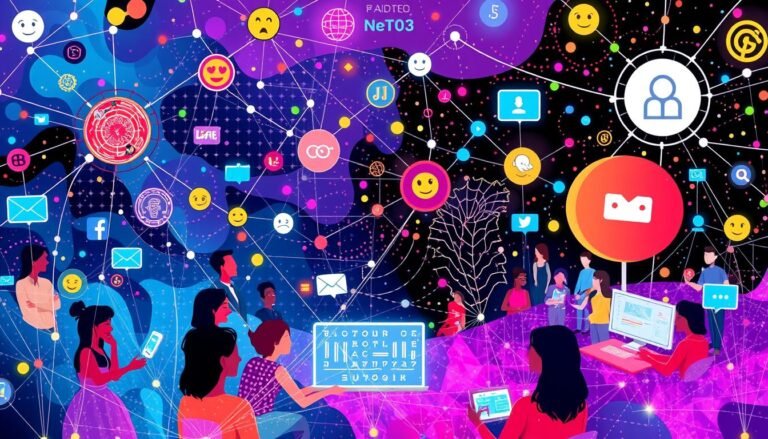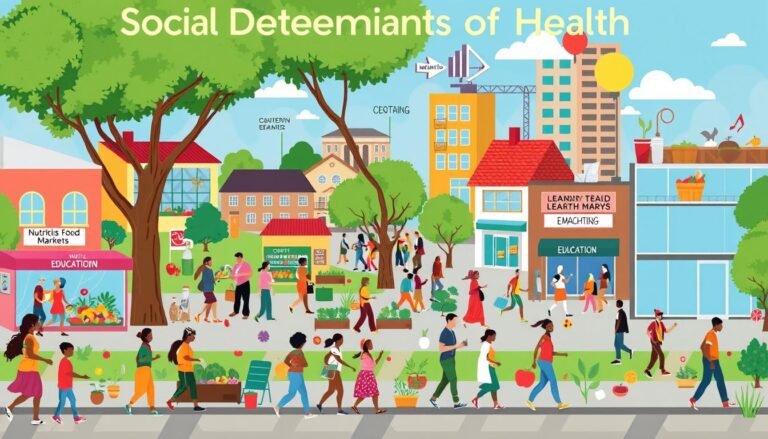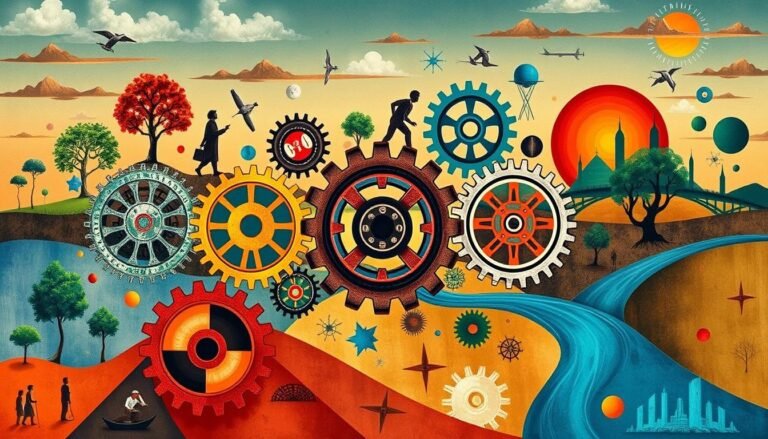Sociology of Religion: Theories of Secularization
Is religion disappearing in our modern world? Sociologists have been wondering about this for years. They look into theories of secularization. The debate between religious decline and modern society has been intense.
Secularization theory says that as societies grow, religion becomes less important. This idea has been a big topic in academic circles. It talks about how people don’t need religion as much in today’s rational world. But, new studies are making us rethink this idea.
The European Values Survey Longitudinal Data File 1981–2018 gives us insights into religious trends in Europe. Along with the World Values Survey, these sources show us how human development affects religious behavior worldwide.
A study in the American Journal of Political Science has found some interesting things. It shows that as people develop, they go to church less. But, their belief in religion doesn’t change much. This challenges the old idea that religion always fades away in modern societies.
Key Takeaways
- Secularization theory predicts religious decline as societies modernize
- Recent studies suggest a more nuanced view of secularization
- Human development negatively affects religious attendance
- Religious belief remains largely unaffected by societal development
- Education and health are key factors influencing religious participation
- The relationship between religion and modernization is complex and multifaceted
Introduction to Secularization Theory
Secularization theory looks at how religion’s influence in society has decreased. It started during the Enlightenment and Industrial Revolution. These events questioned the old religious power.
Definition of Secularization
Secularization means religion is losing its place in our daily lives. We see this through fewer people going to church, changing beliefs, and religion playing a smaller role in public life. Larry Shiner talks about six ways to understand this big change.
Historical Context of Secularization Theory
The Industrial Revolution made people rethink their religious beliefs in Europe. Auguste Comte, a key thinker, came up with a three-stage model for social progress. This helped us see how religion changes in modern times.
Key Proponents of Secularization Theory
Important thinkers like Karl Marx, Max Weber, and Emile Durkheim added a lot to the theory. They looked at how industry changed religion in Europe. Later, David Martin and Peter Berger built on their ideas.
Today, thinkers like Karel Dobbelaere and Jose Casanova have made the theory even more detailed. Dobbelaere talks about secularization at different levels. Casanova suggests we need a deeper look at how religion fits into today’s society, pointing out the hurdles churches face in changing times.
The Rationalization of Society
The rationalization of society is a big change in how we think and act. It’s linked to modernization and losing faith in religion. Now, we look for logical reasons for things instead of religious ones.
In the 1960s, thinkers like Peter Berger and Bryan Wilson talked about secularization. They said as societies get more modern, faith goes down. This change shows up in many parts of life, from what we believe to how we organize things.
Here’s what the numbers show about how rational thinking affects faith:
- In the UK, church attendance fell from 50% of adults in the 1850s to just 7.5% in 2000.
- People don’t believe in God or the afterlife as much anymore.
- Some churches, like Methodism, might not exist by 2030 if things keep going this way.
Max Weber called this change ‘disenchantment.’ Now, we make choices based on logic, not just faith or tradition. We’re using science and facts more to figure out the world.
“Every society has a religious dimension, but modern functional differentiation diminishes the need for socially binding semantics through religion.” – Niklas Luhmann
Rational thinking is changing how we see the world and organize our lives. This ongoing shift brings both challenges and chances for religious groups and followers.
Weber’s Disenchantment of the World
Max Weber’s idea of disenchantment shows how society changed from traditional to modern times. This change is linked to rationalization and modernization. It changed how people see and interact with the world.
Traditional vs. Modern Society
In old societies, religion and superstition were key in guiding people’s actions and views. Weber said that modern times slowly took away these magical elements. They were replaced with more logical reasons for doing things.
| Traditional Society | Modern Society |
|---|---|
| Religious beliefs guide actions | Rational thinking guides actions |
| Magical explanations for phenomena | Scientific explanations for phenomena |
| Church holds significant power | Secular institutions gain influence |
Enlightenment and Industrial Revolution
The Enlightenment and Industrial Revolution sped up the disenchantment process. These events questioned the church’s power and pushed for scientific thinking. This led to a more rational view of the world.
Shift from Religious to Rational Thinking
Weber’s theory shows how society moved from a world ruled by religion to one based on science. This change lessened the impact of magic and superstition. It brought in a more thoughtful way of understanding the world.
“The fate of our times is characterized by rationalization and intellectualization and, above all, by the disenchantment of the world.” – Max Weber
Even with a move towards rational thinking, Weber noted that religion still affects modern society. Religious movements and spiritual beliefs show that the disenchantment process is complex and deep.
Factors Encouraging Rationalization
The process of rationalization has greatly influenced religious decline and secularization. Many factors have played a big part in this change. They have reshaped societies and questioned traditional religious beliefs.
Ascetic Protestantism was a key force in rationalization. It brought a systematic way of worship, focusing on personal effort and hard work. This change helped create a more rational society, moving away from old religious customs.
Scientific knowledge has also been vital. As we learned more about the world, it challenged many religious beliefs. This new understanding of nature led to a “disenchantment of the world,” as Max Weber called it.
Modernization changed how society is organized. Schools, workplaces, and governments became more rational. This shift made religious institutions less influential in daily life. The move towards rationality in daily activities has pushed secularization forward.
Rational ideologies, like Marxism, offered new ways to see society and human behavior. These ideas often conflicted with religious beliefs. This led to a decline in religious authority in many areas of life.
| Factor | Impact on Religion | Example |
|---|---|---|
| Ascetic Protestantism | Promoted rational approach to worship | Emphasis on personal responsibility |
| Scientific Knowledge | Challenged religious worldviews | Scientific interpretation of nature |
| Rational Organization | Eroded influence of religious institutions | Structured schools and workplaces |
| Rational Ideologies | Provided alternative explanations | Marxism’s societal analysis |
Even with these changes, religion still plays a role in today’s societies. Rituals like baptisms and church weddings are still practiced. This shows the complex nature of secularization and the lasting impact of religion on our lives.
Sociology of Religion: Theories of Secularization
Secularization theory looks at how religion’s role in society changes. Over time, new ideas have come up to explain why people believe in religion less today.
Demand-Side Explanations
Demand-side theories say that people need religion less as societies grow. They find comfort and meaning in other areas, not just in religion. This can make people go to church less and believe less in religious teachings.
Supply-Side Explanations
Supply-side theories focus on religious markets. They believe that having more religious choices can make people more involved. With more religions to pick from, people might join one more often.
The GGS Model
The GGS (Grim and Stark) model mixes demand and supply ideas. It says that religious and secular things often replace each other. As people get more from the world, they might want religion less.
| Explanation Type | Focus | Impact on Religious Behavior |
|---|---|---|
| Demand-Side | Societal needs | Decreases as secular alternatives rise |
| Supply-Side | Religious options | Varies based on market competition |
| GGS Model | Secular-religious trade-offs | Declines with increased human development |
These theories give us different ways to see how secularization and religious markets connect. They help us understand how growing human development changes how people act religiously today.
Human Development and Religious Behavior
The link between human development and religious behavior is complex. Studies reveal that as societies grow, people often go to church less but still believe in their faith. This shows how secularization changes in our modern world.
Impact on Religious Attendance
Studies show that as countries get better in education and health, people go to church less. This means secular groups might be taking over roles once filled by churches.
Impact on Religious Belief
But, human development doesn’t really change how people believe. Even in rich countries, many people still believe in their faith, even if they don’t go to church as much. This shows that modern life doesn’t always mean losing faith.
Education and Health as Key Factors
Education and health are big factors in losing faith. Better education means people see more views and might not believe in just one way. Health care also makes people less dependent on faith for help during tough times.
| Factor | Impact on Religious Attendance | Impact on Religious Belief |
|---|---|---|
| Education | Significant decrease | Minimal change |
| Health | Moderate decrease | Minimal change |
| Standard of Living | Slight decrease | No significant change |
This data shows that better living standards can make people go to church less, but it doesn’t mean they lose their faith. The fact that faith stays strong shows religion’s lasting role in our lives, even as it changes.
Criticisms of Secularization Theory
Secularization theory has been a big deal in sociology of religion for a long time. But, it has faced many challenges. Critics say it mainly looks at traditional religion and misses out on new spiritual movements. The growth of New Age spirituality and religious groups in politics shows that religion is still big in today’s world.
One big criticism is that the theory doesn’t explain why religion is still strong in some countries. The United States is a great example. It’s very modern and rational, but people there still believe in religion a lot. This goes against the idea that becoming more modern means becoming less religious.
Another issue is that the theory mainly looks at Western Christianity. Scholars like Pace point out that while some Muslim countries are becoming more secular in politics, others keep a strong link between religion and government. This shows that secularization doesn’t happen the same way everywhere, and it’s not just about being modern.
Recent studies have added more depth to the debate. They show that as people get more developed, they might go to church less, but they don’t necessarily stop believing. This makes the relationship between progress and religion more complicated than we thought, questioning the idea of secularization.
“The desire to secure religious goods declines with the ability to earn secular goods, leading to the decline of religion as societies develop.”
So, the debate on secularization theory is ongoing. It’s a key way to understand how religion is changing in today’s world.
Alternative Models of Religious Change
New ideas are changing how we see religious change in today’s world. These views give us new insights into how religion and society interact.
Religious Markets Model
This model questions the old idea of secularization. It says that with more religious choices, people might actually become more religious. Think of it like a market where different religions compete, making faith more lively.
In places where the government doesn’t control religion, people tend to be more involved with their beliefs.
Persistence of Religion in Modern Society
Even though some thought religion would fade away, it’s still strong in many countries. New religious groups and personal beliefs show how adaptable it is. People are making their own faith paths, moving away from traditional churches.
These new views tell us that religion is not disappearing. They help us see how faith is evolving to meet new challenges. This shows us that religion is still finding its place in our ever-changing world.
Source Links
- Secularization Theory and Religion | Politics and Religion | Cambridge Core
- Theories of Religion and Secularization
- No title found
- Content Pages of the Encyclopedia of Religion and Social Science
- Secularisation – Explained
- Theories of Secularization: Rationalization and the Disenchantment of Society – ReviseSociology
- 04–Green.indd
- Max Weber on Disenchantment: Is Religion Obsolete?
- Modernization – Secularization, Rationalization
- Secularization and religious change – Religion and Psychology Study Guide 2024 | Fiveable
- Religious Pluralism: Evidence of Secularization?
- Peter Berger and the Rise and Fall of the Theory of Secularization
- Secularization
- The Cultural Psychology of Religiosity, Spirituality, and Secularism in Adolescence
- Secularization – Sociology of Religion – iResearchNet
- The Secularisation Thesis | The Religious Studies Project
- Secularization Theory’s Differentiation Problem: Revisiting the Historical Relationship between Differentiation and Religion







